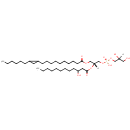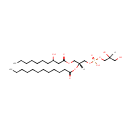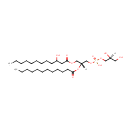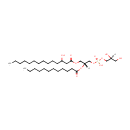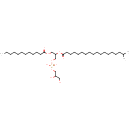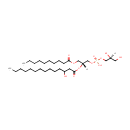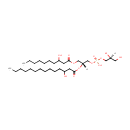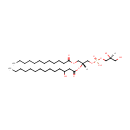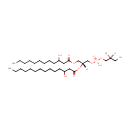
Search Results for compounds
Searching compounds for
returned 4373 results.
Displaying compounds 2221 - 2230 of
4373 in total
PG(12:0(3-OH)/19:0cycv8c) (PAMDB004051)
IUPAC:
[(2S)-2,3-dihydroxypropoxy][(2R)-3-{[10-(2-hexylcyclopropyl)decanoyl]oxy}-2-[(3-hydroxydodecanoyl)oxy]propoxy]phosphinic acid
CAS: Not Available
Description: PG(12:0(3-OH)/19:0cycv8c) is a phosphatidylglycerol. Phosphatidylglycerols consist of a glycerol 3-phosphate backbone esterified to either saturated or unsaturated fatty acids on carbons 1 and 2. As is the case with diacylglycerols, phosphatidylglycerols can have many different combinations of fatty acids of varying lengths and saturation attached to the C-1 and C-2 positions. PG(12:0(3-OH)/19:0cycv8c), in particular, consists of one 3-hydroxydodecanoyl chain to the C-1 atom, and one heptadec-11-12-cyclo-anoyl to the C-2 atom. In Pseudomonas aeruginosa glycerophospholipid metabolism, phosphatidylglycerol is formed from phosphatidic acid (1,2-diacyl-sn-glycerol 3-phosphate) by a sequence of enzymatic reactions that proceeds via two intermediates, cytidine diphosphate diacylglycerol (CDP-diacylglycerol) and phosphatidylglycerophosphate (PGP, a phosphorylated phosphatidylglycerol). Phosphatidylglycerols, along with CDP-diacylglycerol, also serve as precursor molecules for the synthesis of cardiolipin, a phospholipid found in membranes.
PG(12:0(3-OH)/19:iso) (PAMDB004052)
IUPAC:
(2,3-dihydroxypropoxy)({3-[(3-hydroxydodecanoyl)oxy]-2-[(17-methyloctadecanoyl)oxy]propoxy})phosphinic acid
CAS: Not Available
Description: PG(12:0(3-OH)/19:iso) is a phosphatidylglycerol. Phosphatidylglycerols consist of a glycerol 3-phosphate backbone esterified to either saturated or unsaturated fatty acids on carbons 1 and 2. As is the case with diacylglycerols, phosphatidylglycerols can have many different combinations of fatty acids of varying lengths and saturation attached to the C-1 and C-2 positions. PG(12:0(3-OH)/19:iso), in particular, consists of one 3-hydroxydodecanoyl chain to the C-1 atom, and one 17-methylocatdecanoyl to the C-2 atom. In Pseudomonas aeruginosa glycerophospholipid metabolism, phosphatidylglycerol is formed from phosphatidic acid (1,2-diacyl-sn-glycerol 3-phosphate) by a sequence of enzymatic reactions that proceeds via two intermediates, cytidine diphosphate diacylglycerol (CDP-diacylglycerol) and phosphatidylglycerophosphate (PGP, a phosphorylated phosphatidylglycerol). Phosphatidylglycerols, along with CDP-diacylglycerol, also serve as precursor molecules for the synthesis of cardiolipin, a phospholipid found in membranes.
PG(12:0/10:0(3-OH)) (PAMDB004053)
IUPAC:
[(2S)-2,3-dihydroxypropoxy][(2R)-2-(dodecanoyloxy)-3-[(3-hydroxydecanoyl)oxy]propoxy]phosphinic acid
CAS: Not Available
Description: PG(12:0/10:0(3-OH)) is a phosphatidylglycerol. Phosphatidylglycerols consist of a glycerol 3-phosphate backbone esterified to either saturated or unsaturated fatty acids on carbons 1 and 2. As is the case with diacylglycerols, phosphatidylglycerols can have many different combinations of fatty acids of varying lengths and saturation attached to the C-1 and C-2 positions. PG(12:0/10:0(3-OH)), in particular, consists of one dodecanoyl chain to the C-1 atom, and one 3-hydroxydecanoyl to the C-2 atom. In Pseudomonas aeruginosa glycerophospholipid metabolism, phosphatidylglycerol is formed from phosphatidic acid (1,2-diacyl-sn-glycerol 3-phosphate) by a sequence of enzymatic reactions that proceeds via two intermediates, cytidine diphosphate diacylglycerol (CDP-diacylglycerol) and phosphatidylglycerophosphate (PGP, a phosphorylated phosphatidylglycerol). Phosphatidylglycerols, along with CDP-diacylglycerol, also serve as precursor molecules for the synthesis of cardiolipin, a phospholipid found in membranes.
PG(12:0/12:0(3-OH)) (PAMDB004054)
IUPAC:
[(2S)-2,3-dihydroxypropoxy][(2R)-2-(dodecanoyloxy)-3-[(3-hydroxydodecanoyl)oxy]propoxy]phosphinic acid
CAS: Not Available
Description: PG(12:0/12:0(3-OH)) is a phosphatidylglycerol. Phosphatidylglycerols consist of a glycerol 3-phosphate backbone esterified to either saturated or unsaturated fatty acids on carbons 1 and 2. As is the case with diacylglycerols, phosphatidylglycerols can have many different combinations of fatty acids of varying lengths and saturation attached to the C-1 and C-2 positions. PG(12:0/12:0(3-OH)), in particular, consists of one dodecanoyl chain to the C-1 atom, and one 3-hydroxydodecanoyl to the C-2 atom. In Pseudomonas aeruginosa glycerophospholipid metabolism, phosphatidylglycerol is formed from phosphatidic acid (1,2-diacyl-sn-glycerol 3-phosphate) by a sequence of enzymatic reactions that proceeds via two intermediates, cytidine diphosphate diacylglycerol (CDP-diacylglycerol) and phosphatidylglycerophosphate (PGP, a phosphorylated phosphatidylglycerol). Phosphatidylglycerols, along with CDP-diacylglycerol, also serve as precursor molecules for the synthesis of cardiolipin, a phospholipid found in membranes.
PG(12:0/14:0(3-OH)) (PAMDB004055)
IUPAC:
[(2S)-2,3-dihydroxypropoxy][(2R)-2-(dodecanoyloxy)-3-[(3-hydroxytetradecanoyl)oxy]propoxy]phosphinic acid
CAS: Not Available
Description: PG(12:0/14:0(3-OH)) is a phosphatidylglycerol. Phosphatidylglycerols consist of a glycerol 3-phosphate backbone esterified to either saturated or unsaturated fatty acids on carbons 1 and 2. As is the case with diacylglycerols, phosphatidylglycerols can have many different combinations of fatty acids of varying lengths and saturation attached to the C-1 and C-2 positions. PG(12:0/14:0(3-OH)), in particular, consists of one dodecanoyl chain to the C-1 atom, and one 3-hydroxytetradecanoyl to the C-2 atom. In Pseudomonas aeruginosa glycerophospholipid metabolism, phosphatidylglycerol is formed from phosphatidic acid (1,2-diacyl-sn-glycerol 3-phosphate) by a sequence of enzymatic reactions that proceeds via two intermediates, cytidine diphosphate diacylglycerol (CDP-diacylglycerol) and phosphatidylglycerophosphate (PGP, a phosphorylated phosphatidylglycerol). Phosphatidylglycerols, along with CDP-diacylglycerol, also serve as precursor molecules for the synthesis of cardiolipin, a phospholipid found in membranes.
PG(12:0/19:iso) (PAMDB004056)
IUPAC:
(2,3-dihydroxypropoxy)[3-(dodecanoyloxy)-2-[(17-methyloctadecanoyl)oxy]propoxy]phosphinic acid
CAS: Not Available
Description: PG(12:0/19:iso) is a phosphatidylglycerol. Phosphatidylglycerols consist of a glycerol 3-phosphate backbone esterified to either saturated or unsaturated fatty acids on carbons 1 and 2. As is the case with diacylglycerols, phosphatidylglycerols can have many different combinations of fatty acids of varying lengths and saturation attached to the C-1 and C-2 positions. PG(12:0/19:iso), in particular, consists of one dodecanoyl chain to the C-1 atom, and one 17-methylocatdecanoyl to the C-2 atom. In Pseudomonas aeruginosa glycerophospholipid metabolism, phosphatidylglycerol is formed from phosphatidic acid (1,2-diacyl-sn-glycerol 3-phosphate) by a sequence of enzymatic reactions that proceeds via two intermediates, cytidine diphosphate diacylglycerol (CDP-diacylglycerol) and phosphatidylglycerophosphate (PGP, a phosphorylated phosphatidylglycerol). Phosphatidylglycerols, along with CDP-diacylglycerol, also serve as precursor molecules for the synthesis of cardiolipin, a phospholipid found in membranes.
PG(14:0(3-OH)/10:0) (PAMDB004057)
IUPAC:
[(2R)-3-(decanoyloxy)-2-[(3-hydroxytetradecanoyl)oxy]propoxy][(2S)-2,3-dihydroxypropoxy]phosphinic acid
CAS: Not Available
Description: PG(14:0(3-OH)/10:0) is a phosphatidylglycerol. Phosphatidylglycerols consist of a glycerol 3-phosphate backbone esterified to either saturated or unsaturated fatty acids on carbons 1 and 2. As is the case with diacylglycerols, phosphatidylglycerols can have many different combinations of fatty acids of varying lengths and saturation attached to the C-1 and C-2 positions. PG(14:0(3-OH)/10:0), in particular, consists of one 3-hydroxytetradecanoyl chain to the C-1 atom, and one decanoyl to the C-2 atom. In Pseudomonas aeruginosa glycerophospholipid metabolism, phosphatidylglycerol is formed from phosphatidic acid (1,2-diacyl-sn-glycerol 3-phosphate) by a sequence of enzymatic reactions that proceeds via two intermediates, cytidine diphosphate diacylglycerol (CDP-diacylglycerol) and phosphatidylglycerophosphate (PGP, a phosphorylated phosphatidylglycerol). Phosphatidylglycerols, along with CDP-diacylglycerol, also serve as precursor molecules for the synthesis of cardiolipin, a phospholipid found in membranes.
PG(14:0(3-OH)/10:0(3-OH)) (PAMDB004058)
IUPAC:
[(2S)-2,3-dihydroxypropoxy][(2R)-3-[(3-hydroxydecanoyl)oxy]-2-[(3-hydroxytetradecanoyl)oxy]propoxy]phosphinic acid
CAS: Not Available
Description: PG(14:0(3-OH)/10:0(3-OH)) is a phosphatidylglycerol. Phosphatidylglycerols consist of a glycerol 3-phosphate backbone esterified to either saturated or unsaturated fatty acids on carbons 1 and 2. As is the case with diacylglycerols, phosphatidylglycerols can have many different combinations of fatty acids of varying lengths and saturation attached to the C-1 and C-2 positions. PG(14:0(3-OH)/10:0(3-OH)), in particular, consists of one 3-hydroxytetradecanoyl chain to the C-1 atom, and one 3-hydroxydecanoyl to the C-2 atom. In Pseudomonas aeruginosa glycerophospholipid metabolism, phosphatidylglycerol is formed from phosphatidic acid (1,2-diacyl-sn-glycerol 3-phosphate) by a sequence of enzymatic reactions that proceeds via two intermediates, cytidine diphosphate diacylglycerol (CDP-diacylglycerol) and phosphatidylglycerophosphate (PGP, a phosphorylated phosphatidylglycerol). Phosphatidylglycerols, along with CDP-diacylglycerol, also serve as precursor molecules for the synthesis of cardiolipin, a phospholipid found in membranes.
PG(14:0(3-OH)/12:0) (PAMDB004059)
IUPAC:
[(2S)-2,3-dihydroxypropoxy][(2R)-3-(dodecanoyloxy)-2-[(3-hydroxytetradecanoyl)oxy]propoxy]phosphinic acid
CAS: Not Available
Description: PG(14:0(3-OH)/12:0) is a phosphatidylglycerol. Phosphatidylglycerols consist of a glycerol 3-phosphate backbone esterified to either saturated or unsaturated fatty acids on carbons 1 and 2. As is the case with diacylglycerols, phosphatidylglycerols can have many different combinations of fatty acids of varying lengths and saturation attached to the C-1 and C-2 positions. PG(14:0(3-OH)/12:0), in particular, consists of one 3-hydroxytetradecanoyl chain to the C-1 atom, and one dodecanoyl to the C-2 atom. In Pseudomonas aeruginosa glycerophospholipid metabolism, phosphatidylglycerol is formed from phosphatidic acid (1,2-diacyl-sn-glycerol 3-phosphate) by a sequence of enzymatic reactions that proceeds via two intermediates, cytidine diphosphate diacylglycerol (CDP-diacylglycerol) and phosphatidylglycerophosphate (PGP, a phosphorylated phosphatidylglycerol). Phosphatidylglycerols, along with CDP-diacylglycerol, also serve as precursor molecules for the synthesis of cardiolipin, a phospholipid found in membranes.
PG(14:0(3-OH)/12:0(3-OH)) (PAMDB004060)
IUPAC:
[(2S)-2,3-dihydroxypropoxy][(2R)-3-[(3-hydroxydodecanoyl)oxy]-2-[(3-hydroxytetradecanoyl)oxy]propoxy]phosphinic acid
CAS: Not Available
Description: PG(14:0(3-OH)/12:0(3-OH)) is a phosphatidylglycerol. Phosphatidylglycerols consist of a glycerol 3-phosphate backbone esterified to either saturated or unsaturated fatty acids on carbons 1 and 2. As is the case with diacylglycerols, phosphatidylglycerols can have many different combinations of fatty acids of varying lengths and saturation attached to the C-1 and C-2 positions. PG(14:0(3-OH)/12:0(3-OH)), in particular, consists of one 3-hydroxytetradecanoyl chain to the C-1 atom, and one 3-hydroxydodecanoyl to the C-2 atom. In Pseudomonas aeruginosa glycerophospholipid metabolism, phosphatidylglycerol is formed from phosphatidic acid (1,2-diacyl-sn-glycerol 3-phosphate) by a sequence of enzymatic reactions that proceeds via two intermediates, cytidine diphosphate diacylglycerol (CDP-diacylglycerol) and phosphatidylglycerophosphate (PGP, a phosphorylated phosphatidylglycerol). Phosphatidylglycerols, along with CDP-diacylglycerol, also serve as precursor molecules for the synthesis of cardiolipin, a phospholipid found in membranes.
